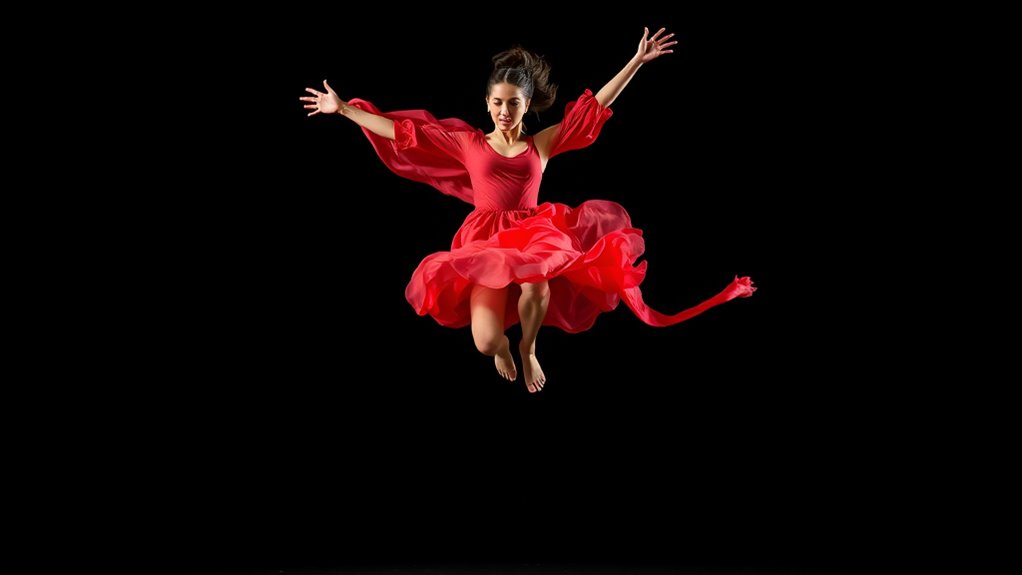Performance art is about moving beyond traditional art forms by engaging you directly in live, participatory experiences. Instead of just observing, you’re encouraged to respond, move, and interact, making you an active part of the artwork. This breaks down barriers between the audience and artist, creating spontaneous and intimate connections. By exploring how materials and actions evoke emotion and challenge norms, you’ll discover how art becomes a living conversation—if you keep exploring, you’ll uncover even more.
Key Takeaways
- Performance art transforms passive viewers into active participants, blurring boundaries between artist and audience.
- It emphasizes spontaneity and improvisation, creating unique, live experiences in each encounter.
- Audience engagement involves movement, speech, and decision-making, shaping the artwork’s meaning and energy.
- Use of tactile materials and themes adds symbolic depth, emotional resonance, and visual richness.
- The art form fosters visceral connections, breaking down barriers and creating shared moments of live expression.

Have you ever wondered how art can go beyond traditional paintings and sculptures to engage audiences directly? Performance art does just that by transforming the usual passive viewing into an active experience. Instead of hanging on a wall or sitting quietly in front of a canvas, you become part of the artwork itself. This genre thrives on interactive engagement, encouraging you to move, respond, or even influence what’s happening on stage. Audience participation isn’t just a side element; it’s often the core of the piece, blurring the lines between artist and viewer. When you step into a performance, you’re not just watching; you’re contributing to the meaning and energy of the event.
Performance art invites you to actively participate, transforming viewers into essential parts of the creative experience.
In performance art, the audience isn’t a static observer but a crucial component of the creative process. Artists craft situations that invite you to participate, breaking down traditional boundaries of art consumption. You might be asked to speak, move, or make decisions that alter the course of the piece. This active involvement creates a dynamic and unpredictable experience, making each encounter unique. The immediacy of performance art means that your presence, reactions, and even your silence shape the outcome. It’s a deliberate choice to invite you into the art, making you feel seen and heard rather than just an outsider looking in. The use of materials like wood and metal can also add tactile and visual layers to the performance, enriching the overall experience. Additionally, the choice of materials can influence the emotional tone and thematic depth of the work, emphasizing the physicality of the performance.
This emphasis on interaction fosters a sense of shared experience. Instead of a solitary encounter with a finished object, you’re part of a live, unfolding narrative. Your participation can challenge societal norms, question authority, or explore personal identity—all in real time. The artist often designs these moments to provoke thought or emotion through your direct involvement. Whether it’s through dialogue, movement, or physical action, your role becomes integral to the message being conveyed. It’s this active engagement that transforms performance art from a static statement into a living conversation. Moreover, the incorporation of audience participation can deepen the emotional impact and create memorable moments that resonate long after the performance ends.
Moreover, performance art’s fluid nature allows for spontaneity. As an audience member, you might find yourself in a situation that feels intimate or confrontational, depending on what the artist aims to explore. This immediacy fosters a visceral connection that traditional art forms rarely achieve. You’re not just an observer but a participant who helps shape the event’s energy and meaning. The power of performance art lies in its capacity to break down barriers—between artist and audience, performer and spectator—and create a shared space of live expression. It’s an art form that invites you to step in, engage, and make the experience uniquely yours. Additionally, incorporating different materials such as wood and metal can elevate the aesthetic appeal and interaction within the performance setting. The tactile qualities of these materials can also symbolize themes of strength, vulnerability, or industrialization, adding further layers to the narrative.
Frequently Asked Questions
How Does Audience Interaction Influence Performance Art?
Audience interaction profoundly shapes performance art by fostering engagement and creating dynamic, unpredictable moments. When you actively participate, you influence the artist’s choices, making the experience more personal and immersive. Interactive dynamics blur the line between performer and viewer, allowing your reactions to drive the performance forward. This exchange heightens emotional impact, making each encounter unique and memorable, ultimately transforming the art into a shared, live expression of collective creativity.
What Are the Origins of Performance Art Globally?
Imagine peeling back layers of history like an onion, revealing the roots of performance art worldwide. Its historical origins stretch from avant-garde movements in early 20th-century Europe to indigenous rituals across Africa, Asia, and the Americas. Cultural influences shape its evolution, blending societal issues with personal expression. These diverse origins demonstrate how performance art is a mirror reflecting humanity’s shared desire to communicate beyond words, making it a truly global phenomenon.
How Do Artists Prepare Mentally for Live Performances?
You prepare mentally for live performances by practicing mindfulness techniques to stay present and focused. You might breathe deeply or meditate to calm nerves and enhance emotional resilience, helping you handle unexpected moments. Visualizing success and reaffirming your purpose boost confidence. By maintaining a positive mindset and managing stress, you guarantee you’re fully engaged, allowing your authentic expression to shine through during your performance.
What Are Common Challenges Faced During Performance Art Pieces?
During performance art, you often face challenges like technical difficulties that disrupt your flow and audience disengagement that makes it hard to connect. These issues can cause stress and throw you off balance. To overcome them, you need quick thinking, adaptability, and strong communication skills. Staying calm and prepared helps you navigate these hurdles, ensuring your performance remains authentic and impactful despite unexpected setbacks.
How Is Performance Art Documented and Preserved for Future Viewing?
You wonder how performance art is captured for eternity. It’s a delicate process—using video recordings to document fleeting moments, yet maintaining their essence requires careful archival preservation. With each frame, you hold a piece of live expression, safeguarding it from time’s erosion. This meticulous process ensures future viewers can experience the raw emotion and artistry, making ephemeral moments enduring for generations to come.
Conclusion
Performance art is like a living canvas, constantly changing and inviting you to step into its vibrant world. It breaks boundaries, blending motion with emotion to create a raw, unforgettable experience. As you witness these moments unfold, remember that you’re part of the artwork itself—a fleeting brushstroke in a grand masterpiece. Embrace the chaos and beauty, for in performance art, life becomes your most expressive act.









